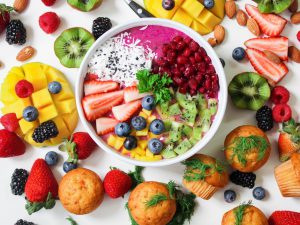Congratulations! You’re pregnant! If your dreams of sitting on the couch using your big pregnant belly as a table for your giant bowl of ice cream have been squashed with a devastating diagnosis of gestational diabetes, look no further for tips on how to happily and healthily navigate the last months of pregnancy. While it might feel like the end of the world, it’s not and once you have the right information you can tackle the rest of your pregnancy with ease.
What is Gestational Diabetes?

Gestational diabetes is a type of diabetes that is diagnosed only during pregnancy and usually goes away after thebaby is born. It is a very frustrating and confusing diagnosis because doctors are not sure what the exact cause of it is, but it’s believed to be due to hormones produced by the placenta. A pregnant woman is typically tested for gestational diabetes between weeks 24 and 28 of pregnancy. It causes high blood sugar that can affect your pregnancy and your baby’s health so you want to be very cautious and attentive in the event you get diagnosed.
What Dietary Changes Can Be Made?

Usually there are no symptoms of gestational diabetes so if you get diagnosed it is pretty sudden and shocking. And since you get tested in your second trimester you’re probably used to a certain way of eating since you’ve become pregnant, not to mention the hormones are raging. When your doctor tells you that you have gestational diabetes you need to take in a lot of information as quickly as possible so you can make changes to your lifestyle and diet immediately but here are some tips to help accept your new way of life.
-
Eat smaller meals Perhaps you skip breakfast altogether or maybe you cram your meals into 3 larger meals of breakfast, lunch, and dinner. This can have an adverse effect on your blood sugar making it hard to stabilize your levels. Since gestational diabetes affects your blood sugar, regulation is the name of the game. You want to avoid binging altogether so that spikes in your blood sugar don’t occur and one simple way to do that is by eating small, healthy meals and snacks throughout the day. Start eating small snacks in between smaller meals. Creating a meal plan that includes all your snacks with exactly what you’re going to eat and when takes the guesswork out of it, making that aspect of your new diagnosis less stressful. Bonus: it doubles as an easy way to grocery shop as well.
- Add more protein to your meals and snacks. Since carbohydrates affect blood sugar it’s important to try and monitor the amount you eat and drink. Try a string cheese with a cracker or a scrambled egg on wheat toast. High fiber carbs paired with a lean protein help blood sugar levels while delivering you and your baby the nutrients you need.
- Stay away from sugary drinks and juices. You may think that having a glass of orange juice or ordering a smoothie from your local juice joint are healthy choices, but not when you have gestational diabetes. Stick with water or a sugar free tea when you’re thirsty. Try seltzer and adding a lemon or lime if you want something different. Juices have a ton of sugars and carbs and will spike your blood sugar. Get a cute reusable water bottle so you always have something on hand so if you’re out you’re not tempted to order a soda or juice.
What’s The Big Deal?

You may be sitting there thinking “what’s the big deal? I only have a few weeks left of pregnancy. I don’t need to worry about my diet.” Well, the consequences of not managing and addressing gestational diabetes far outweigh taking the easy road and ignoring the issue entirely. If you continue eating as if you didn’t have gestational diabetes your baby is at risk of gaining a lot of weight up until delivery. In a normal pregnancy, a baby will gain around ½ pound per week and the average birth weight is about 7.5lbs. If you don’t manage your gestational diabetes, you’re more likely to gain weight as well as put your baby at risk of being born at a higher weight which doctors call macrosomia. Macrosomia is defined as babies that weigh more than 8 pounds, 13 ounces at birth and you want to avoid that if at all possible. Preterm birth is also a concern if gestational diabetes is not treated. If diagnosed you want to address it as soon as possible so that you and your baby have an uneventful and healthy pregnancy and birth.
Because gestational diabetes puts a woman into a high risk category it is important to have a health insurance plan that covers all your needs. We offer a wide range of health insurance plans from top-rated insurance companies in every state. Contact EZ for a free, no obligation quote on all available plans in your area. To get free instant quotes, simply enter your zip code in the bar above, or to speak to a local agent, call 888-350-1890.







